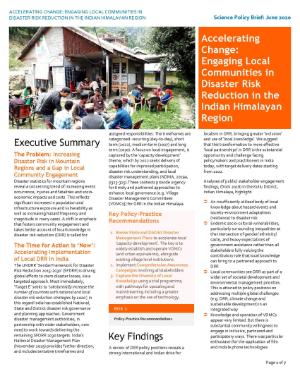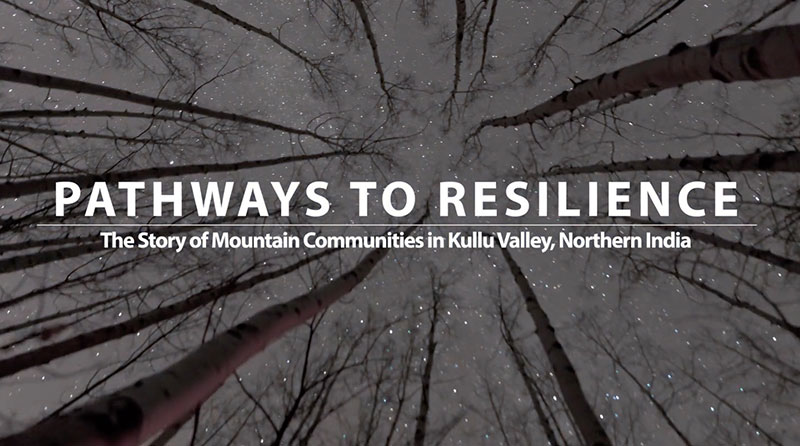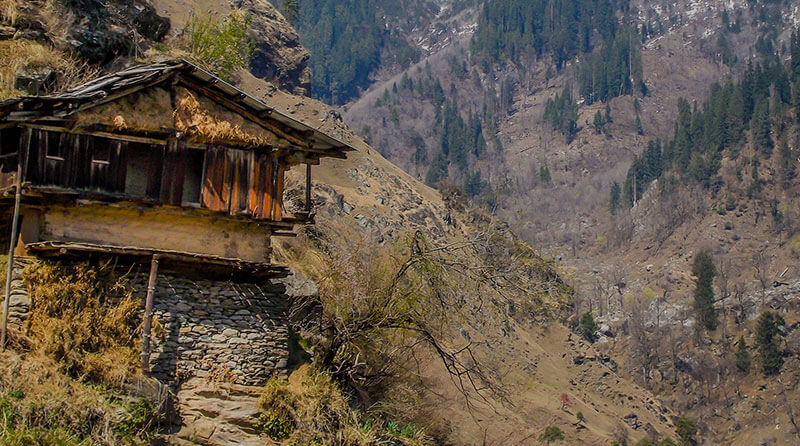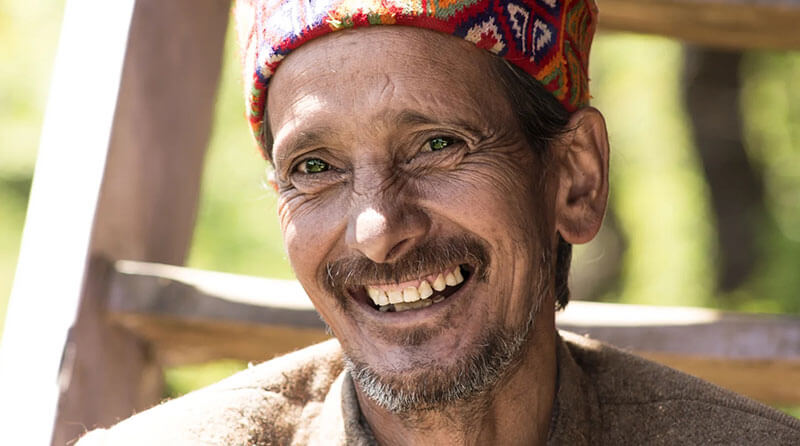Pathways to Resilience
Pathways to Resilience adopts interdisciplinary approaches to hazard and disaster knowledge, seeking to empower lasting impact to bolster disaster resilience in India's Kullu District.
Project background
The Hazard and Disaster Global Challenge
Hazards such as floods, landslides, and earthquakes continue to pose severe risks to vulnerable communities, especially in low/middle-income countries. Asia has shown recent increases in disaster impacts and in the period 1996-2015, India suffered the fifth largest disaster mortality (CRED-UNISDR 2016). Responding to this global challenge, the current thinking of the United Nations is outlined by the 'Sendai Framework for Disaster Risk Reduction' (2015-2030) (UNISDR, 2015). This promotes ‘shared responsibility’ and ‘resilience’ as key responses to bring disaster risk reduction (DRR) and sustainable development gains. This approach is adopted by the Indian ‘National Disaster Management Plan’ (2019).
Risk in the Indian Himalaya
Despite global efforts to stem disaster losses mountain regions remain particularly sensitive (e.g. Hewitt and Mehta, 2012; Gardner, 2015). Indeed the Indian Himalayan, Kullu District (Himachal Pradesh) has high levels of risk to environmental hazards (e.g. Gardner 2002). In particular, floods are of a high-frequency and magnitude, resulting in damage, disruption and fatality (e.g. Ballesteros-Canovas et al., 2017). The region is also undergoing rapid change due to urban population growth, increasing tourism, and hydro-electric power construction and is prone to climate change and variability. These conditions act to modify the vulnerability, exposure and risk; manifest in continuing disaster losses, making it all the more important to implement effective disaster risk reduction strategies.
In this vein, our ‘Pathways to Resilience’ research has brought improved empirical understanding of complex hazard and risk conditions, with a particular emphasis on flooding. Working in partnership with local communities, international HEIs, Indian government agencies, and NGOs we are using interdisciplinary and participatory methodologies to contribute to DRR efforts. We explore environmental and societal dimensions of flooding via historical documents, landscape evidence, indigenous community oral histories and professional film production. These approaches have enabled us to ignite local understanding and seed collaboration amongst stakeholders to improve DRR policy and practice. Film is particularly important in this process, since film connects people, stirring hearts and minds, fostering valuable bonds between local communities, agencies and researchers over a prolonged time (Penrhyn Jones, 2019). Together our traditional research outputs, alongside film and public engagement activities, foster local ownership of the DRR challenge by giving voice to local people. This academic/community knowledge and practice has the capacity to generate bottom-up resilience policy-practice shifts in the face of disaster.
This project also brings a significant methodological contribution to academia, by demonstrating the value of interdisciplinary approaches in obtaining, sharing and applying new knowledge for complex global challenges such as disaster risk reduction. ‘Pathways to Resilience’ is part of this emerging/innovative frontier which is bringing together creative expression (i.e. film) and the geographical sciences. Film brings alive the arguments we may otherwise make more dryly and with less impact in traditional academic outputs. Film can convey complex, hard-to-visualise arguments in more compelling ways. The ‘Pathways to Resilience’ films deliver a vivid feel for the social, cultural and landscape context. Our films reveal the complex relationships between physical and human systems, the research process, and its results and impacts. As researchers this creative turn has opened doors to new ways of thinking which we never previously envisaged, for example, we have been able to explore DRR issues by deeply linking socio-cultural, geomorphological, hydro-meteorological and disaster governance perspectives. We hope our experience inspires other researchers to apply interdisciplinary methods to international research questions and work outside their usual ‘comfort zone’.
Ballesteros-Canovas J., Mohan D., Stoffel M., Khan M.A., Kuriger J., and Sinha S. (2017) Science Brief: Flood risk and early warning systems. The Indian Himalayas Climate Adaptation Programme (IHCAP).
CRED-UNISDR (2016) Poverty and death: disaster mortality 1996–2015. UNISDR, Geneva.
Gardner J.S. (2002) Natural hazards risk in the Kullu District, Himachal Pradesh, India. Geographical Review, 92(2):282–306.
Gardner J.S. (2015) Risk complexity and governance in mountain environments.
In: Fra. Paleo U (ed) Risk governance: the articulation of hazard, politics and ecology. Springer, London, pp 349–371.
Hewitt K., Mehta M. (2012) Rethinking risk and disasters in mountain areas. Journal of Alpine Research, 100(1):1–12.
National Disaster Management Plan (2019). A publication of the National Disaster Management Authority, Government of India. November 2019, New Delhi.
Penrhyn Jones S. (2019) Broadening Understanding of Environmental Communication Through Theory and Practice. The International Journal of Creative Media Research, 2, September 2019.
UNISDR (2015) Sendai Framework for disaster risk reduction 2015–2030. UNISDR, Geneva.
Research process
Our research interest was sparked by our first explorations of mountain catchments littered with flood evidence and consequent encounters with village communities and their stories of past disasters in the Kullu District. When placed in the wider context of repeated disaster impacts in the region and newly developing disaster risk reduction policy agendas, the opportunity to bring new research-led contributions to local resilience policy-practice and broader academic debate was readily apparent. From these beginnings in 2012, the ‘Pathways to Resilience’ research project has emerged and evolved, as a long-duration, multi-partner, international and interdisciplinary research endeavour. Spanning our academic, film, and science policy brief outputs, interconnected research questions include:
- What is the history, causation and environment-society system impacts of hazard/disaster events, focusing on floods, in the Phojal Nalla catchment, Kullu District?
- What expressions of local vulnerability and resilience exist in mountain communities following past disaster impacts and in the face of new development pressures?
- How are vulnerability and resilience manifest via the concepts of heritage and capital?
- What are the principal local concerns, aspirations and priorities for disaster risk reduction/sustainable development?
- How can we bring enhanced resilience from existing local, indigenous and science knowledge?
- How can local knowledge be more effectively harnessed in local governance structures (i.e. Village Disaster Management Committees) and policy contexts?
- How can the medium of film be used to both give voice-to and forge connections between local communities, responsible agencies and researchers in disaster risk reduction, to empower locally led approaches to resilience generation?
A broad suite of methods were deployed in the ‘Pathways to Resilience’ project to generate the traditional academic outputs, films and science policy brief. Spanning the data collection-analysis-dissemination-engagement interface these include:
- Village and catchment geomorphological reconnaissance. Observational walks around villages, their surrounds and flood impacted catchment channels and hillslopes. These were in participation with and at times according to the priorities of the local community. Observations were recorded using photographs, notes, map annotation and GPS waypoints.
- Semi-structured interviews. These were conducted with Pahari-Hindi-English interpreters, with respondents being sampled by appointment (i.e. persons with societal responsibility) and opportunistically amongst the wider community. These interviews primarily in the Kullu District (>130, ranging 10-120 mins) used scheduled questions, were recorded by video and handwritten notes, enabling subsequent transcription and coding for analysis.
- Archive and contemporary data searches. Documentary materials have been extensively and systematically reviewed in India, UK and USA. Exploring the catalogues and selected holdings of archives, libraries, universities, research institutes, learned societies, private collections (including British India family descendants in the UK) and government departments.
- Film production. As a multi-organisation, international research team, together we were involved in the underpinning research, and film specific funding applications, logistical planning/production, audio-visual capture, scripting, narration, editing, and public release. The local community had a significant participatory role, with the content of these films highlighting their perspectives. Working together over several years, we reflect their interview narratives and guidance on footage capture locations. Kraft Films played an important role in the film capture and editing process.
- Village and stakeholder workshops. In June and October 2018, a combination of film screenings, break-out and plenary discussion, were hosted in mountain villages and in Kullu (GBPNIHE Himachal Unit, and the District Government (DDMA) stand at the Dussehra fair). These recorded respondent views by notes, video, and post-it-note charting. Translations Hindi to English (where required) and transcription followed.
- Screening events. These have showcased the films to promote further stakeholder reflection and discussion amongst two principal audiences: (i) academic, government and NGO stakeholders; (ii) public. Responses are captured using a mixture of questionnaires, semi-structured interview and focus group discussion.
- Media engagements. A press conference was hosted in partnership with the Kullu District Government (DDMA) and GBPNIHE in Kullu, in October 2018. This included the advance issue of a press release (in Hindi and English) detailing the research project, a film screening preview, and a question and answer session. This resulted in TV interviews and newspaper reports to promote public engagement.
- Online film distribution. The primary hosting location for the films is Vimeo. This is augmented via government agency/university website hosting. Using social media the film was shared more broadly. In all cases we invite reflection and further discussion.
- Science policy brief production and outreach. Key activity included local questionnaire surveys (April and June 2018), village and stakeholder workshops (above) and analysis of global DRR policy positions. Interactive webinar events (August and September 2020) facilitated discussion of the policy brief findings and policy-practice recommendations. These were attended by Indian Government Authorities, NGOs and research organisations, from across the wider Indian Himalayan Region and further afield.
Research insights
These are detailed on Bath Spa’s ResearchSPAce. Three outputs provide detailed articulation of the research process, insights and the initial public engagement in June 2018. As such they span the academic to policy-practice arena, engaging with disaster risk reduction debates and the specific challenges in the Indian Himalaya. They provide the core research that underpins the film production and narrative. These publications are:
Johnson, R.M., Edwards, E., Gardner, J. and Mohan, B. (2014) 'Village heritage and resilience in damaging floods and debris flows, Kullu Valley, Indian Himalaya.' In: Convery, I., Corsane, G. and Davis, P. (eds.) Displaced heritage: responses to disaster, trauma, and loss. Heritage matters. Boydell Press, Woodbridge, pp. 207-224. Open Access book chapter.
This is the first peer-reviewed output of the project. It is an interdisciplinary approach to understanding the August 1994 flood disaster in the Kullu District. It provides a science and social science account of the flood causation, environmental and societal impacts and societal responses. It continues with an evaluation of the relationship between heritage and community resilience, concluding with recommended approaches for improving local resilience.
Johnson, R.M., Edwards, E., Gardner, J.S. and Diduck, A.P. (2018) 'Community vulnerability and resilience in disaster risk reduction: an example from Phojal Nalla, Himachal Pradesh, India'. Regional Environmental Change, 18 (7): 2073-2087. View-only, full-text access via Springer Nature SharedIt.
With an extension of empirical data since 2014, this builds the analysis of community vulnerability and resilience following disaster events in the Kullu District. This is positioned in the context of disaster risk reduction policies operating between local-national-international scales. We conclude that ‘knowledge’ is the principal driver of resilience conditions, in terms of availability, sharing and usage. These results are central to the films, in terms of their narrative, but also methodologically. Film production was the next step in this research, as a tool for knowledge generation and sharing in local disaster risk reduction efforts.
Kuniyal, J.C., Johnson, R.M. and Edwards, E. (2019) Disaster Risk Reduction in the Kullu District, Himachal Pradesh, India. Current Science, 117(4) 25 August 2019: 557-559. Open Access.
In line with our participatory and partnership approach to research, this article outlines details of our first stakeholder workshops in mountain villages and Kullu in June 2018, which used the Hindi film to catalyse discussion. We present local risk management perspectives and development aspirations, and make recommendations for improved DRR policy and practice. This research project is actively leading on these recommendations, i.e. (i) extend outreach of DRR messages to improve awareness and engagement; (ii) extend international partnerships and networks to diversify perspectives; and (iii) work with government agencies and local communities to evolve disaster management plans.
The main creative output includes three versions of the ‘Pathways to Resilience’ film, detailing the same Kullu District disaster history and resilience generation theme, but crafted for different audiences. These films vary from five to 21 minutes, and work in both Hindi and English languages. In viewing these we would ask for each film to be viewed in full, to the end, in one sitting. This generates appreciation of their interconnecting content and argument. Furthermore, when all three films are viewed together they bring a greater collective understanding of the research method, findings and recommendations.
Film screenings (see later) amongst academic, government, NGO and public audiences, were followed by audience reflection and discussion of disaster risk reduction measures. In this regard, they have proven an excellent catalytic tool for stakeholder engagement from which to generate and assess the societal impact of this research. Importantly, they provide a universal means of connecting people and fostering valuable bonds between local communities, researchers, and government. This partnership approach opens doors to knowledge that was never previously envisaged and builds bridges between stakeholders to enhance the disaster risk reduction effort.
Three versions of the ‘Pathways to Resilience’ film collection include:
- Pathways to Resilience - AMCDRR: A five-minute English language film produced as a competition entry for the eighth Asian Ministerial Conference on Disaster Risk Reduction, in July 2018 (AMCDRR). This event was inter-governmental, and was jointly hosted by the Government of Mongolia and the United Nations Office for Disaster Risk Reduction (UNISDR, now renamed as UNDRR). This version provides advocacy to an international policy-practice audience for local partnership approaches for developing community resilience as a mechanism for disaster risk reduction.
- Pathways to Resilience - AHRC: A 21-minute English language film produced as a competition entry for the UK Arts and Humanities Research Council's (AHRC) ‘Research in Film Awards 2018’, in the category of ‘Best Research Film of the Year’. This version provides a wider framing of the underlying research project journey, research questions, and our partnerships. It provides greater methodological focus and demonstrates the benefits of bringing understandings from the arts and humanities into dialogue with those in the sciences and social sciences. This is a clear expression of interdisciplinary/international research responding to global challenges of disaster risk and sustainable development, which are a growing UKRI priority.
- Pathways to Resilience - Hindi: A 15-minute Hindi language film produced for public engagement in the Kullu District and beyond. This version builds on the core ideas of the preceding versions, but takes the next step; it directly empowers local people to discuss what they already know and most importantly what they could individually and collectively contribute to improving DRR in the Kullu District. This film has been screened extensively (see later).
Underpinned by our academic research, films and stakeholder engagement activities, our latest (June 2020) contribution is a science policy brief with supplementary research datasets.
The ‘Accelerating Change: Engaging Local Communities in Disaster Risk Reduction in the Indian Himalayan Region’ briefing can be openly accessed (in full, with supplementary data) via our institutional research data repository (BathSPAdata). It has also been widely disseminated (in part, without supplementary data) by esteemed external organisations, including: All India Disaster Mitigation Institute (AIDMI); GBPNIHE; Global Network of Civil Society Organisations for Disaster Reduction (GNDR), UNDRR Prevention Web, and the Zurich Flood Resilience Portal. The key audience for this briefing is the Indian disaster management policy-practice community, including Government Authorities, NGOs and Research Organisations.
This briefing details the problem of increasing disaster risk in mountain regions alongside a gap in local community engagement. We call for a shift in emphasis, to foster inclusive community engagement, which takes better account of local knowledge in disaster risk reduction.
Specific recommendations are:
- Revision of State and District disaster management plans
- Implementation of comprehensive awareness campaigns; and
- Programmes to capture the diversity of local knowledge.
Read the Science policy brief
Dissemination
‘Pathways to Resilience’ has been shown in different versions and audience contexts, including academic workshops/conferences in Northern India, mountain village and stakeholder gatherings in the Kullu District, the Kullu Dussehra festival on a large public screen, short clips on Indian TV (Zee News), and a full 15-minute version embedded in the Kullu District government disaster management website. Audience reflections include:
A resident of the village of Phojal after a film screening in June 2018 expressed:
"Many congratulations that you have told us about the natural disaster… from the film we felt that we should increase awareness amongst people."
Central Tibetan Administration, Dobhi, in June 2018 expressed:
"From the film we learnt a lot about disaster risks and their respective management. It has triggered our awareness and sense of responsibility."
The Kullu District government (Additional District Magistrate, October 2018) state:
"The movie is well made and interesting… it stresses unless and until community participation is there in the disaster management, no matter how many plans we make, district administration will not be able to do the disaster management effectively… this is the message we want to spread regarding disaster management and mitigation of losses, that is helping us. I really thank you!"
The International Union for Conservation of Nature (IUCN, India, October 2018) articulate:
"It is important to understand the landscape and how it works – not only intellectually, but also emotionally and spiritually; and the film produced succeeds admirably in this task."
Academic, Government/NGO stakeholder events
- 19 June 2018: UGC-UKIERI HiFlo-DAT Workshop 1, University of Delhi including NGOs, Himachal Pradesh and Kullu government officials (AHRC version)
- 29 June 2018: GBPNIHE/BSU workshop, Mohal-Kullu, including NGOs, government officials and local community representatives (Hindi version)
- 18 October 2018: Private screening with the International Roerich Memorial Trust, Naggar, Kullu District (Hindi version)
- 22 October 2018: University of Delhi workshop exploring the impact of the Sept. 2018 Kullu District floods, Delhi (Hindi version)
- 23-24 October 2018: Private screenings with IUCN India (Delhi) and TISS (Mumbai) (Hindi version)
- 18 April 2019: C2E2 Himalaya 2019, International Workshop on Climate Change and Extreme Events in the Himalayan Region, IIT Mandi (Hindi version)
- 2 and 10 May 2019: Himachal Pradesh University, Shimla – five-minute extract to the UGC Human Resource Development Centre event op. 132; and full screening to an international student group (Hindi version)
- 21 October 2019: 13th International Geographical Union – India Conference, Central University of Haryana (Hindi version)
- 24-25 October 2019: Two invited lectures at University of Delhi: Shaheed Bhagat Singh College; and Kirori Mal College (Hindi version)
Public-engagement events
- 25-28 June 2018: five mountain villages (Kukri, Neri, Phojal, Runga and Dobhi) in the Kullu District (Hindi version)
- 18 October 2018: Kullu government press conference, Kullu (Hindi version)
- 20 October 2018: Kullu International Dussehra Festival, Kullu. In partnership with the Kullu government, multiple showings on their stand, and also showcase screening on the large public display system (Hindi version)
Online
In addition to multi-platform social media (released in February 2019 via Twitter, Facebook, You Tube and WhatsApp), the film link and/or commentary are embedded on the following websites:
- Kullu District Disaster Management Authority (DDMA), India
- Kraft Films, India
- The University of Winnipeg, Canada
Traditional Media
There has been coverage of the work in regional TV Bulletins (Zee News, 20-21 October 2018) and Hindi language newspapers (Aapka Faisla, Amar Ujala, Danik Jagran, Punjab Kesari – 19 October 2018).
Policy-Practice Webinars
- 14 August 2020: BSU/GBPNIHE co-hosted event ‘Accelerating Change in DRR’ (Google Meet)
- 4 September 2020: GBPNIHE event ‘Adaptation & Resilience Building Challenges for the Himalayan Communities: Climate Change and Covid-19’ (Webex Meet)
Project images
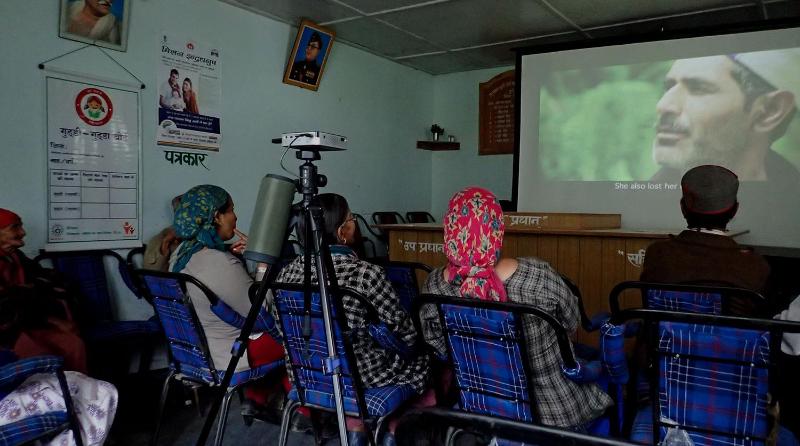
Mountain Village Workshop (Phojal, Kullu District, 27 June 2018): Film screening in the local community.
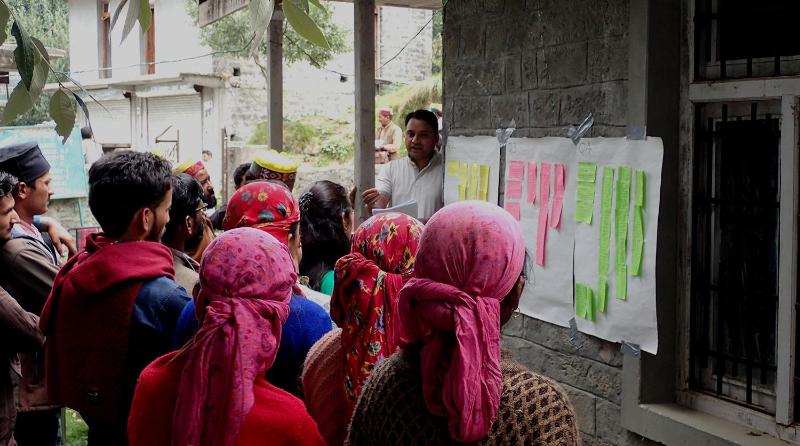
Mountain Village Workshop (Neri, Kullu District, 26 June 2018): A plenary discussing questions in the film.
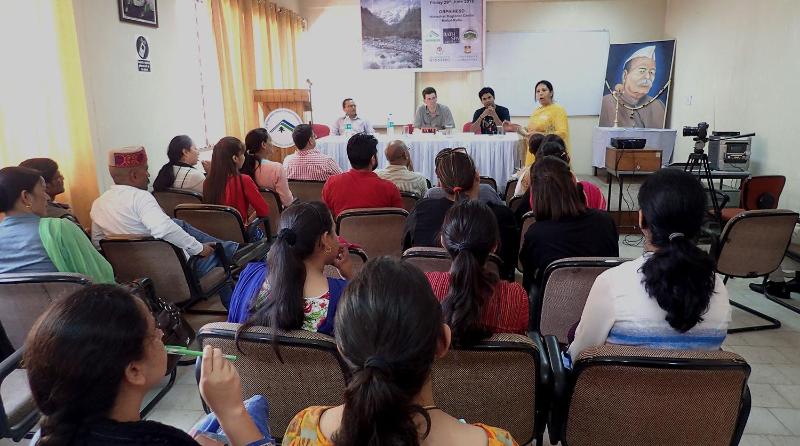
Stakeholder Workshop (Kullu, at G.B. Pant National Institute of Himalayan Environment, 29 June 2018): DRR discussions.
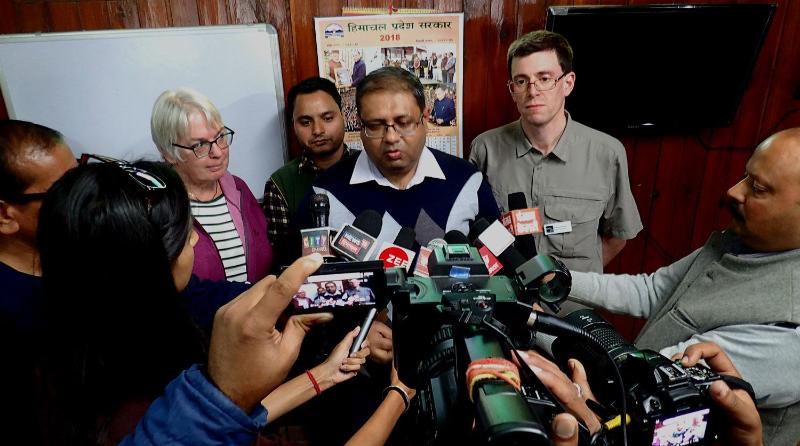
Project press conference with academic and government partners (Kullu, 18 October 2018).
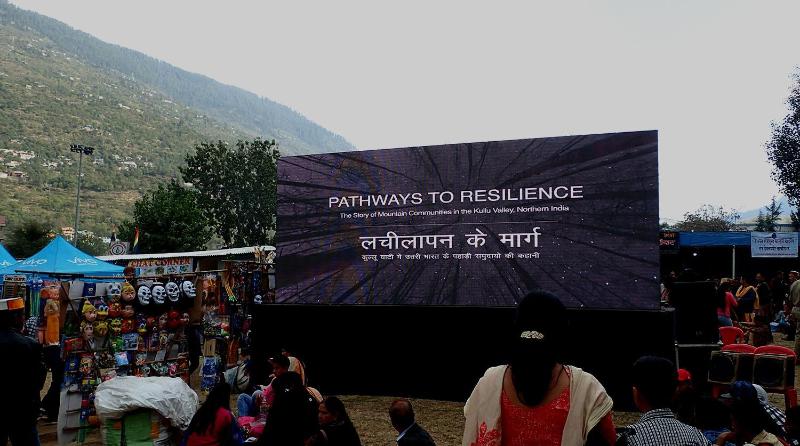
Kullu Dussehra Festival, large format film screening (20 October 2018).
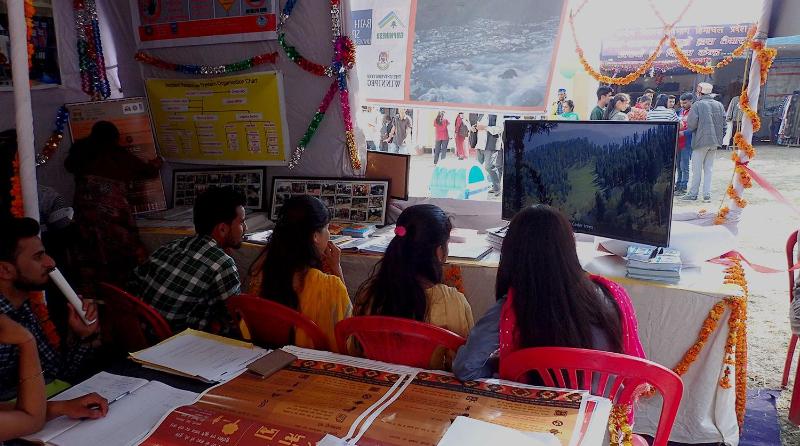
Kullu Dussehra Festival, District government stand for screening and discussion (20 October 2018).
Project partners
The films are the direct endeavour of Bath Spa University, Kraft Films (Bangalore) and the the G.B. Pant National Institute of Himalayan Environment, in collaboration with Indian government authorities and the local communities. They are underpinned by the research endeavours of our tri-lateral project team (as listed below).
- Dr Richard Johnson
- Dr Esther Edwards
- G.B. Pant National Institute of Himalayan Environment (GBPNIHE):
- Himachal Pradesh University, Shimla
- University of Manitoba, Winnipeg
- Professor James Gardner (Emeritus)
- University of Winnipeg, Winnipeg
Mr Pushpam Singh, Bath Spa Almnus and founder of Kraft Films, Bangalore.
Funding
We are grateful to the following organisations for providing funding for this project.
- Bath Spa University (indirect 2012-, direct 2018-2020)
- Santander Universities Scheme (indirect, 2016)
- The University of Winnipeg (indirect, 2015)
- UGC-UKIERI HiFlo-DAT (indirect, 2018-2020)
